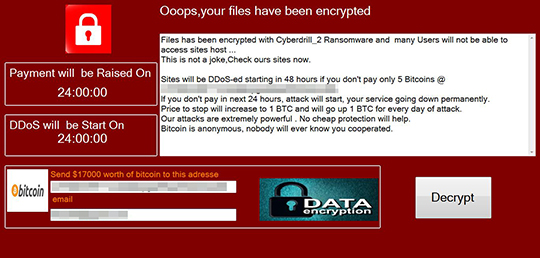RANSOM_HIDDENTEARDRILL.A
Ransom.CyberDrill (Malwarebytes); Ransom:MSIL/Ryzerlo.A (Microsoft); Ransom.HiddenTear!g1 (Symantec)
Windows


Threat Type: Ransomware
Destructiveness: No
Encrypted: No
In the wild: Yes
OVERVIEW
Dropped by other malware, Downloaded from the Internet
This Ransomware arrives on a system as a file dropped by other malware or as a file downloaded unknowingly by users when visiting malicious sites.
It connects to certain websites to send and receive information.
It encrypts files with specific file extensions. It encrypts files found in specific folders. It drops files as ransom note.
TECHNICAL DETAILS
162,816 bytes
EXE
No
21 Sep 2017
Connects to URLs/IPs, Displays message/message boxes, Encrypts files
Arrival Details
This Ransomware arrives on a system as a file dropped by other malware or as a file downloaded unknowingly by users when visiting malicious sites.
Autostart Technique
This Ransomware adds the following registry entries to enable its automatic execution at every system startup:
HKEY_CURRENT_USER\SOFTWARE\Microsoft\
Windows\Currentversion\Run
My appication = "{Executed Malware Filename}"
Process Termination
This Ransomware terminates processes or services that contain any of the following strings if found running in the affected system's memory:
- Taskmgr
Other Details
This Ransomware connects to the following website to send and receive information:
- http://{BLOCKED}.{BLOCKED}.1.100/CyberdrillCandC/password.php?
It displays a pop-up window with the following message:

Ransomware Routine
This Ransomware encrypts files with the following extensions:
- .png
- .jpg
It encrypts files found in the following folders:
- %Desktop%
(Note: %Desktop% is the desktop folder, where it usually is C:\Documents and Settings\{user name}\Desktop in Windows 2000, Windows Server 2003, and Windows XP (32- and 64-bit); C:\Users\{user name}\Desktop in Windows Vista (32- and 64-bit), Windows 7 (32- and 64-bit), Windows 8 (32- and 64-bit), Windows 8.1 (32- and 64-bit), Windows Server 2008, and Windows Server 2012.)
It appends the following extension to the file name of the encrypted files:
- .cyberdrill
It drops the following file(s) as ransom note:
- %Desktop%\test\READ_IT.txt
(Note: %Desktop% is the desktop folder, where it usually is C:\Documents and Settings\{user name}\Desktop in Windows 2000, Windows Server 2003, and Windows XP (32- and 64-bit); C:\Users\{user name}\Desktop in Windows Vista (32- and 64-bit), Windows 7 (32- and 64-bit), Windows 8 (32- and 64-bit), Windows 8.1 (32- and 64-bit), Windows Server 2008, and Windows Server 2012.)
It leaves text files that serve as ransom notes containing the following text:
- Files has been encrypted with Cyberdrill_2 Ransomware,and many Users will not be able to access sites host ... This is not a joke,Check ours sites now. Sites will be DDoS-ed starting in 24 hours if you don't pay only 30 Bitcoins @ {BLOCKED}KHtF11CAd5eHpgmdPaz8723NvLG63. If you don't pay in next 24 hours, attack will start, your service going down permanently. Price to stop will increase to 1 BTC and will go up 1 BTC for every day of attack. Our attacks are extremely powerful . No cheap protection will help.Bitcoin is anonymous, nobody will ever know you cooperated.
SOLUTION
9.850
13.674.08
22 Sep 2017
13.675.00
23 Sep 2017
Step 1
Before doing any scans, Windows XP, Windows Vista, and Windows 7 users must disable System Restore to allow full scanning of their computers.
Step 2
Note that not all files, folders, and registry keys and entries are installed on your computer during this malware's/spyware's/grayware's execution. This may be due to incomplete installation or other operating system conditions. If you do not find the same files/folders/registry information, please proceed to the next step.
Step 3
Identify and terminate files detected as RANSOM_HIDDENTEARDRILL.A
- Windows Task Manager may not display all running processes. In this case, please use a third-party process viewer, preferably Process Explorer, to terminate the malware/grayware/spyware file. You may download the said tool here.
- If the detected file is displayed in either Windows Task Manager or Process Explorer but you cannot delete it, restart your computer in safe mode. To do this, refer to this link for the complete steps.
- If the detected file is not displayed in either Windows Task Manager or Process Explorer, continue doing the next steps.
Step 4
Delete this registry value
Important: Editing the Windows Registry incorrectly can lead to irreversible system malfunction. Please do this step only if you know how or you can ask assistance from your system administrator. Else, check this Microsoft article first before modifying your computer's registry.
- In HKEY_CURRENT_USER\SOFTWARE\Microsoft\Windows\Currentversion\Run
- My appication = "{Executed Malware Filename}"
- My appication = "{Executed Malware Filename}"
Step 5
Search and delete this file
- %Desktop%\test\READ_IT.txt
Step 6
Scan your computer with your Trend Micro product to delete files detected as RANSOM_HIDDENTEARDRILL.A. If the detected files have already been cleaned, deleted, or quarantined by your Trend Micro product, no further step is required. You may opt to simply delete the quarantined files. Please check the following Trend Micro Support pages for more information:
Step 7
Restore encrypted files from backup.
Did this description help? Tell us how we did.

